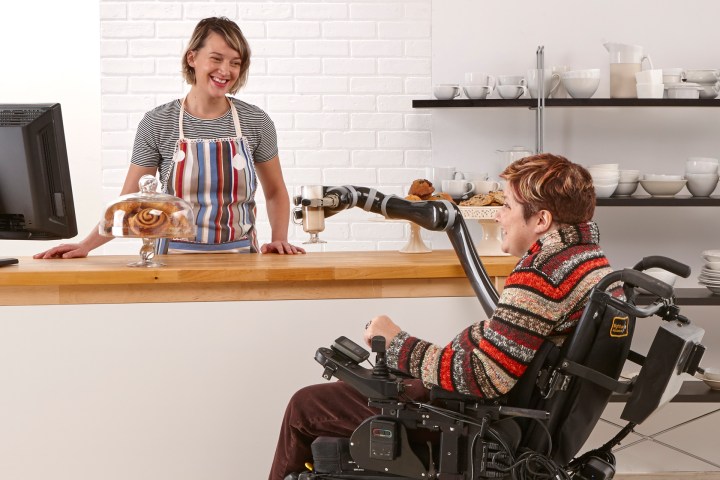
When it comes to the real life-changing technologies, many are found in the accessibility market. These technologies may never appear on the radar of many of the people reading this article, but can prove transformative for those who need them.
Tech improves our lives every day in a million ways beyond simply making things more convenient. Here are the companies and people fighting to make a difference.
One such device is Canadian tech company Kinova Robotics’ Jaco arm, a lightweight, carbon fiber robotic arm which attaches to any power wheelchair available on the market. Controlled by the user, the robo-arm provides three fingers and six degrees of freedom. It can be used for a wide range of everyday tasks.
“The arm plugs in to the user’s battery source, and can then be controlled through whatever mechanism the user uses to control their chair,” Sarah Woolverton, who heads the marketing and communication at Kinova, told Digital Trends. “That could be a joystick, a sip-and-puff or whatever else; we can tap into them all. It makes it very, very easy to start using the arm because it’s just an extension of the wheelchair that they’re already using.”
The best technologies are problem-solving exercises, and in the case of the Jaco arm, the problem was one extremely close to home for company co-founder, Charles Deguire. His uncle — after whom the “Jaco” arm is named — suffered from muscular dystrophy. This severe muscle degenerative disease causes the weakening and eventual breakdown of skeletal muscles. There is currently no cure, and it severely compromises the independence of patients that it affects.
“That inspired our CEO to want to create something that could assist people with limited upper mobility,” Woolverton continued. “He went into engineering and, along with our co-founder, developed the first Kinova Jaco. That was 12 years ago. Ever since, we’ve been working hard to improve on the product.”
Today, Kinova Robotics has offices in Canada, Germany, and the U.S. Its robot arms have advanced significantly, particularly in the fine-grain movements its owners can accomplish.
“It allows people to do things in their daily lives which seem quite simple to many of us, such as being able to pick up a drink, open a door, even put on their makeup,” Woolverton said. “Previously these are all things a lot of our users were not able to do on their own. It really gives a degree of independence. We’ve heard tremendous stories about what people manage to achieve in just a few days of starting to use the arm. They feel so proud of themselves. It’s quite inspiring!”
“It’s important to make sure that insurance companies recognize this can augment independence and help save on costs on other things…”
One inspiring story shared by Kinova involves Mary Nelson, an 11-year-old girl with spinal muscular atrophy, who uses her Jaco arm to care for her horses on her parent’s farm. “It’s certainly true that younger users catch on particularly quickly,” Woolverton said. “I was at a trade show recently and within minutes, a seven-year-old was using the arm to pick up a glass and drink from it. But we’ve not seen any resistance from older users, either.”
The golden age of assistive tech
Right now, the biggest challenge isn’t getting users to appreciate what a Jaco arm can give them; it’s actually getting the arms to the users in the first place. Woolverton said that it’s “much easier” to do this in places like Germany because the arm is covered by medical insurance codes. In the United States, that’s not yet possible. The Jaco arm needs to be purchased by customers and many can’t afford it.
“The affordability is an issue to us,” Woolverton said. “We have been focusing predominantly on the markets which have open insurance reimbursement codes. I mean, it’s a $35,000 product, so it’s not accessible to everyone otherwise.”
But she does see some evidence that things are changing. “We’re being accepted more and more. I think, ultimately, the market will open up in the years to come. It’s an education thing: It’s a new technology, so it’s important to make sure that insurance companies recognize that this can augment independence and help save on costs on other things, such as caregivers. It’s a colossal amount of work, but we’re getting there.”
In the meantime, the team has plenty of ideas for moving forward. One project it is working on is a lower-cost version of the Jaco arm, which should make it more affordable to customers who have to front the full cost themselves. However, as Woolverton notes, this will come with its own challenges — namely functionality. “It would mean sacrificing things like payload and speed.”





